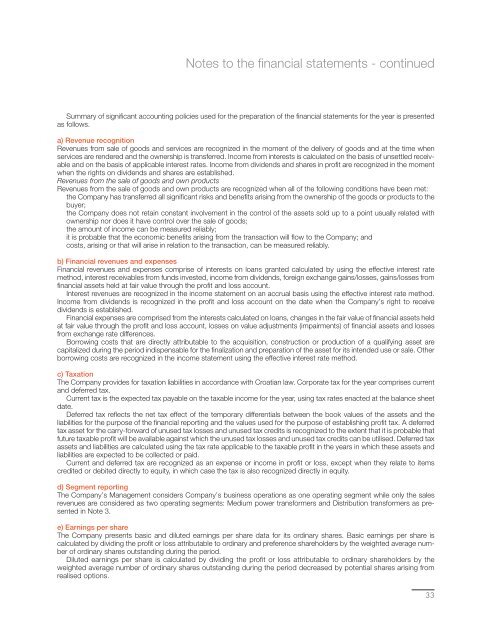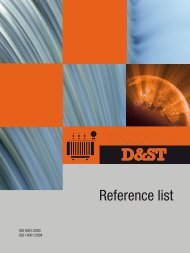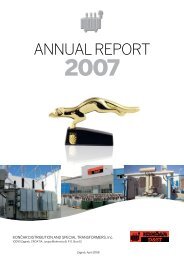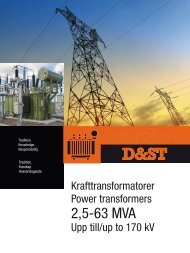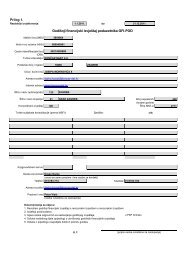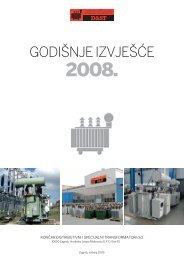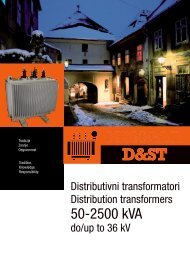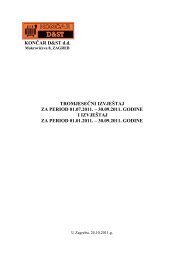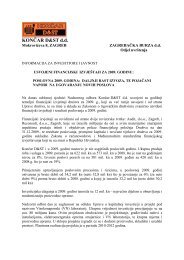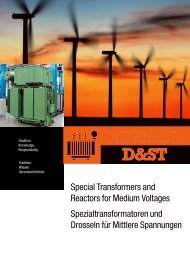Annual Report - KonÄar Distribution and Special Transformers Inc.
Annual Report - KonÄar Distribution and Special Transformers Inc.
Annual Report - KonÄar Distribution and Special Transformers Inc.
You also want an ePaper? Increase the reach of your titles
YUMPU automatically turns print PDFs into web optimized ePapers that Google loves.
Notes to the financial statements - continued<br />
Summary of significant accounting policies used for the preparation of the financial statements for the year is presented<br />
as follows.<br />
a) Revenue recognition<br />
Revenues from sale of goods <strong>and</strong> services are recognized in the moment of the delivery of goods <strong>and</strong> at the time when<br />
services are rendered <strong>and</strong> the ownership is transferred. <strong>Inc</strong>ome from interests is calculated on the basis of unsettled receivable<br />
<strong>and</strong> on the basis of applicable interest rates. <strong>Inc</strong>ome from dividends <strong>and</strong> shares in profit are recognized in the moment<br />
when the rights on dividends <strong>and</strong> shares are established.<br />
Revenues from the sale of goods <strong>and</strong> own products<br />
Revenues from the sale of goods <strong>and</strong> own products are recognized when all of the following conditions have been met:<br />
the Company has transferred all significant risks <strong>and</strong> benefits arising from the ownership of the goods or products to the<br />
buyer;<br />
the Company does not retain constant involvement in the control of the assets sold up to a point usually related with<br />
ownership nor does it have control over the sale of goods;<br />
the amount of income can be measured reliably;<br />
it is probable that the economic benefits arising from the transaction will flow to the Company; <strong>and</strong><br />
costs, arising or that will arise in relation to the transaction, can be measured reliably.<br />
b) Financial revenues <strong>and</strong> expenses<br />
Financial revenues <strong>and</strong> expenses comprise of interests on loans granted calculated by using the effective interest rate<br />
method, interest receivables from funds invested, income from dividends, foreign exchange gains/losses, gains/losses from<br />
financial assets held at fair value through the profit <strong>and</strong> loss account.<br />
Interest revenues are recognized in the income statement on an accrual basis using the effective interest rate method.<br />
<strong>Inc</strong>ome from dividends is recognized in the profit <strong>and</strong> loss account on the date when the Company’s right to receive<br />
dividends is established.<br />
Financial expenses are comprised from the interests calculated on loans, changes in the fair value of financial assets held<br />
at fair value through the profit <strong>and</strong> loss account, losses on value adjustments (impairments) of financial assets <strong>and</strong> losses<br />
from exchange rate differences.<br />
Borrowing costs that are directly attributable to the acquisition, construction or production of a qualifying asset are<br />
capitalized during the period indispensable for the finalization <strong>and</strong> preparation of the asset for its intended use or sale. Other<br />
borrowing costs are recognized in the income statement using the effective interest rate method.<br />
c) Taxation<br />
The Company provides for taxation liabilities in accordance with Croatian law. Corporate tax for the year comprises current<br />
<strong>and</strong> deferred tax.<br />
Current tax is the expected tax payable on the taxable income for the year, using tax rates enacted at the balance sheet<br />
date.<br />
Deferred tax reflects the net tax effect of the temporary differentials between the book values of the assets <strong>and</strong> the<br />
liabilities for the purpose of the financial reporting <strong>and</strong> the values used for the purpose of establishing profit tax. A deferred<br />
tax asset for the carry-forward of unused tax losses <strong>and</strong> unused tax credits is recognized to the extent that it is probable that<br />
future taxable profit will be available against which the unused tax losses <strong>and</strong> unused tax credits can be utilised. Deferred tax<br />
assets <strong>and</strong> liabilities are calculated using the tax rate applicable to the taxable profit in the years in which these assets <strong>and</strong><br />
liabilities are expected to be collected or paid.<br />
Current <strong>and</strong> deferred tax are recognized as an expense or income in profit or loss, except when they relate to items<br />
credited or debited directly to equity, in which case the tax is also recognized directly in equity.<br />
d) Segment reporting<br />
The Company’s Management considers Company’s business operations as one operating segment while only the sales<br />
revenues are considered as two operating segments: Medium power transformers <strong>and</strong> <strong>Distribution</strong> transformers as presented<br />
in Note 3.<br />
e) Earnings per share<br />
The Company presents basic <strong>and</strong> diluted earnings per share data for its ordinary shares. Basic earnings per share is<br />
calculated by dividing the profit or loss attributable to ordinary <strong>and</strong> preference shareholders by the weighted average number<br />
of ordinary shares outst<strong>and</strong>ing during the period.<br />
Diluted earnings per share is calculated by dividing the profit or loss attributable to ordinary shareholders by the<br />
weighted average number of ordinary shares outst<strong>and</strong>ing during the period decreased by potential shares arising from<br />
realised options.<br />
33


